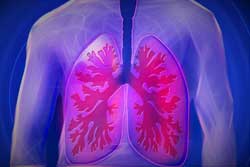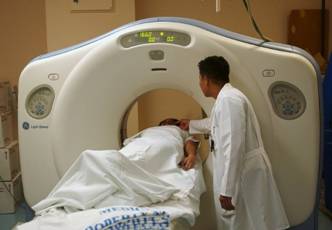Archives
Study Evaluates Impact of Care Management Programs on COPD Readmission Rates
 Acute exacerbation of chronic obstructive pulmonary disease (AECOPD) is one of the leading causes of hospitalization in the U.S. Due to the condition's significant financial and health burdens, healthcare organizations and government agencies throughout the nation are striving to reduce its frequency.
Acute exacerbation of chronic obstructive pulmonary disease (AECOPD) is one of the leading causes of hospitalization in the U.S. Due to the condition's significant financial and health burdens, healthcare organizations and government agencies throughout the nation are striving to reduce its frequency.
A recent study published in the American Journal of Managed Care analyzed both the clinical and psychosocial risk factors associated with readmissions for COPD exacerbations, with a focus on patients treated at Danbury Hospital, an academic community hospital which implemented a comprehensive care management program (CCMP) and chronic obstructive pulmonary disease (COPD) readmission reduction initiative. An exacerbation was defined as increased cough, sputum or dyspnea in a patient with COPD, as well as a change in sputum color.
“The Agency for Healthcare Research and Quality estimates that 1 out of every 5 patients over the age of 40 who have been hospitalized in the past decade carries a diagnosis of COPD,” noted the study. “Given its prevalence in hospitalized patients, COPD and its acute exacerbation pose a heavy financial burden in health care.”
Throughout the study, researchers collected data on patients with AECOPD, which included an assessment of their clinical comorbidities, such as pneumonia, cognitive disorders and smoking status. Patients' psychosocial risk factors, including anxiety, home safety, and access to transportation, were also analyzed. It was revealed that out of 272 patients, 20 were readmitted within 30 days of their index hospitalization.
Those who were readmitted had a higher rate of pneumonia at readmission and were more likely to have safety issues at home, anxiety and lack of transportation. There was no significant difference between those who were readmitted and those who were not in regard to their age, smoking status, gender or body mass index (BMI). Research also revealed that after one-year post implementation of the CCMP, the hospital's annual readmission rate decreased from 21.5 percent to 13.6 percent.
“From a community hospital that has successfully reduced readmissions for AECOPD after implementation of our CCMP, we speculate that a CCMP can reduce readmission rates with careful execution of a program that includes optimization of in-hospital care, better coordination of pre- and post-discharge care, attention to social variables, a system to better identify patient problems after discharge, and an office setup that can accommodate same day sick visits,” concluded the study.
Click Here to Access the Full Article in the American Journal of Managed Care
Antidepressant Use in People with COPD Linked to Increased Risk of Death and Hospitalization
 A recent study published the European Respiratory Journal finds that individuals with chronic obstructive pulmonary disease (COPD) who take antidepressants have a 20 percent increased likelihood of death as well as a 15 percent increased risk of hospitalization due to related symptoms.
A recent study published the European Respiratory Journal finds that individuals with chronic obstructive pulmonary disease (COPD) who take antidepressants have a 20 percent increased likelihood of death as well as a 15 percent increased risk of hospitalization due to related symptoms.
In fact, the study suggests that adults with COPD who are new users of serotonergic antidepressants have a higher likelihood of hospitalization, emergency room visits and respiratory condition-related mortality, as well as a higher rate of death overall when compared to non-users of the antidepressants.
"We were not surprised by these findings, as there are biological reasons why antidepressants could lead to respiratory issues," said Dr. Nicholas Vozoris, a scientist in the Li Ka Shing Knowledge Institute of St. Michael's Hospital and the lead author. "These drugs can cause sleepiness, vomiting and can negatively impact immune system cells. This increases the likelihood of infections, breathing issues, and other respiratory adverse events, especially in patients with COPD."
“COPD is a progressive lung disease that causes increasing breathlessness. It affects more than 10 percent of those aged 40 and older worldwide. Because of the nature of the disease, upwards of 70 percent of those with COPD also struggle with symptoms of low mood and anxiety,” said Dr. Vozoris.
Vozoris and his team leveraged health administrative databases from the Institute of Clinical Evaluative Sciences to analyze more than 28,000 individuals with COPD who recently began to use serotonergic antidepressants and were 66 years of age or older. The study revealed that these individuals had a significantly increased rate of both breathing-related and overall death.
"The study results should not cause alarm among those who use these medications, but rather increase caution among patients and physicians," Dr. Vozoris said. "I hope our study encourages increased awareness when prescribing these medications and monitoring for adverse side effects. Also, because there is this association, we as physicians should give thought to psychotherapy and pulmonary rehabilitation as non-drug related treatment."
Temple Researchers Find Success in Minimally Invasive Treatment for Emphysema
More than three million individuals in the U.S. have been diagnosed with emphysema, commonly associated with smoker's lung and long-term tobacco use. The condition is a related form of chronic obstructive pulmonary disease (COPD) and the severity of it has proven to be fatal.
 Although treatments for emphysema exist, they often require intensive and risky lung volume reduction surgeries to help remove damaged tissue, which can lead to infections, respiratory failure and additional severe complications. In turn, researchers continue to search for less invasive treatment methods to enable patients to resume active lifestyles.
Although treatments for emphysema exist, they often require intensive and risky lung volume reduction surgeries to help remove damaged tissue, which can lead to infections, respiratory failure and additional severe complications. In turn, researchers continue to search for less invasive treatment methods to enable patients to resume active lifestyles.
In a recent clinical trial, researchers at Temple University revealed the benefits of a new, minimally invasive emphysema endoscopic lung reduction therapy that utilizes a one-way valve to deflate damaged areas of the lungs. Over 190 patients with emphysema participated in the university's LIBERATE clinical trial and were implanted with the Zephyr Endobronchial Valve. The findings were presented at the ATS 2018 International Conference and published in the American Journal of Respiratory and Critical Care Medicine.
“The LIBERATE trial was designed to see whether Zephyr EBV was safe and effective over a relatively longer time frame, out to one year,” said Gerard Criner, chair and professor of thoracic medicine and surgery at the Lewis Katz School of Medicine, who served as principal investigator of the study.
The valve, which was implanted using a bronchoscope and flexible delivery catheter, prevents the hyperinflation caused by air that is trapped in damaged lung tissue. This approach, in turn, is intended to "mimic the mechanism of lung volume reduction surgery, shrinking the diseased regions and enabling more efficient functioning in healthier regions."
Researchers also discovered that the valve helped to reduce shortness of breath, improve lung function and enhance quality of life for at least one year after the implantation.
Traffic-related pollution linked to risk of asthma in children
Although physicians have long understood that the prevalence of smog and pollution can lead to asthma attacks, uncertainty has remained regarding the impact of long-term pollutant exposure on the development of the disease among children. Recent research, however, has shed light into this.
 A study, published in the Journal of Allergy and Clinical Immunology, reveals that children who experience long-term exposure to traffic-related pollution, especially throughout early childhood, may have a significantly increased risk of developing pediatric asthma.
A study, published in the Journal of Allergy and Clinical Immunology, reveals that children who experience long-term exposure to traffic-related pollution, especially throughout early childhood, may have a significantly increased risk of developing pediatric asthma.
"Our previous research demonstrated that living close to a major roadway and lifetime exposure to air pollutants were associated with lower lung function in seven- to ten-year-old children," said corresponding author Mary B. Rice, MD, MPH. "We suspected that these exposures would also be associated with pediatric asthma."
Researchers analyzed data from more than 1,500 children who were born between 1999 and 2002, lived in the Boston-area and had mothers who were enrolled in a long-term study known as Project Viva. Researchers developed the study to examine the impact of behavioral and environmental factors, including exposure to pollution, on children's health.
During Project Viva, mothers provided medical, socio-economic and demographic information, which was later leveraged by Rice and her colleagues to determine the distance between each child's home address and the closest major roadway. Children's home addresses were also linked to both census and satellite-derived atmospheric data to determine each child's approximate daily exposure to fine particulate matter (PM). The children's daily exposure to soot was also examined. Upon analysis of the geographic data and Project Viva questionnaires, researchers discovered that living close to a major road was linked to childhood asthma.
"Children living less than 100 meters from a major road had nearly three times the odds of current asthma -- children who either experience asthma symptoms or use asthma medications daily -- by ages seven to 10, compared with children living more than 400 meters away from a major road," said Rice. "Even in the Boston area, where pollution levels are relatively low and within Environmental Protection Agency standards, traffic-related pollutants appear to increase the risk of asthma in childhood."
"Younger children spend a larger proportion of their time at home than school-aged children, and their airways are smaller and may be more likely to wheeze in response to pollution," said Rice. "This may explain why pollution exposure was most consistently linked to asthma in young children."
Three-Quarters of COPD Cases are Linked to Childhood Risk Factors that are Exacerbated in Adulthood
 According to a study published in The Lancet Respiratory Medicine journal, three-quarters of chronic obstructive pulmonary disease (COPD) cases are caused by poor lung function pathways that are developed during childhood. The study revealed that both childhood illnesses, such as asthma and pneumonia, and exposure to parental smoking are also linked to COPD. A second study published in the journal also suggested that there may be a "window of opportunity" during childhood to help reduce the risk of poor lung function in the future.
According to a study published in The Lancet Respiratory Medicine journal, three-quarters of chronic obstructive pulmonary disease (COPD) cases are caused by poor lung function pathways that are developed during childhood. The study revealed that both childhood illnesses, such as asthma and pneumonia, and exposure to parental smoking are also linked to COPD. A second study published in the journal also suggested that there may be a "window of opportunity" during childhood to help reduce the risk of poor lung function in the future.
“These findings highlight the importance of preventing both early life adverse exposures that could lead to poorer lung growth, and adult risk factors contributing to accelerated lung decline,” said study author Professor Shyamali Dharmage. “Reduction of maternal smoke exposure and personal smoking and promotion of immunization are identified as public health targets to prevent poor lung function pathways.”
The first study measured more than 2,400 participants' lung function from childhood to the age of 53. Researchers discovered three pathways that define how lung function changes with age in relation to COPD - below average lung function in early life and a rapid decline in lung function in later life, continuously low lung function and below average lung function.
These three pathways contributed to an estimated three-quarters of all cases of COPD occurring among participants at the age of 53 and were also linked to childhood asthma, pneumonia, parents with asthma or smoking habits, and the participants themselves having asthma or smoking habits.
Throughout the second study, the lung function of more than 2,600 participants was measured from birth to the age of 24. Nearly three-quarters of infants, aged one to six months, that had poor lung function were documented to have improved throughout their childhood, indicating a possible window of opportunity to increase lung function and reduce the risk of developing COPD.
"Childhood risk factors are important indicators of COPD risk, that are aggravated by smoking and having asthma in adulthood. This amplifies the damage already caused by childhood risk factors and may result in a more rapid decline in lung function," said the researchers. "As a result, it will be important to reduce parental smoking, encourage immunization, and avoid smoking to promote healthy lung function pathways and minimize COPD risk, especially for people who had low childhood lung function or whose parents smoked."
Putting the Brakes on Lung Disease
 When an individual has emphysema, or chronic obstructive pulmonary disease (COPD), their lung tissues are destroyed by chronic inflammation, which is largely caused by specialized white blood cells known as neutrophils and macrophages. Although these cells can effectively combat lung infections, they can also attack the lung's elastic fibers leading to breathing difficulties and chest infections.
When an individual has emphysema, or chronic obstructive pulmonary disease (COPD), their lung tissues are destroyed by chronic inflammation, which is largely caused by specialized white blood cells known as neutrophils and macrophages. Although these cells can effectively combat lung infections, they can also attack the lung's elastic fibers leading to breathing difficulties and chest infections.
While a cure for COPD does not currently exist, a recent study published in The Journal of Clinical Investigation suggests that COPD and co-associated medical problems can be prevented by directly “blocking” the G-CSF protein that is known to commonly stimulate the production of white blood cells.
“We found elevated levels of G-CSF in mice with COPD, and when it was eliminated, the excessive numbers of white blood cells in their lungs were markedly reduced and the lungs themselves no longer became diseased,” said the senior author of the study, immunologist Associate Professor Margaret Hibbs.
Researchers discovered that by adjusting the dose of any eventual therapeutic, they may have the ability to maintain white blood cells' infection-fighting capabilities as well as prevent the damage that leads to COPD. The study could potentially provide the key for the first ever treatment that prevents the disease from progressing. It could also provide a new ‘biomarker’ to screen patients and identify COPD much earlier.
“When we blocked G-CSF, the effect was absolutely striking. It prevented not only the emphysema but also the wider medical problems, whether it be the heart, muscles or bone. We realized we had uncovered a potential pathway for treatments," said collaborator Professor Gary Anderson, director of the Lung Health Research Centre at the University of Melbourne. “We now have a very good case that we have indeed found a mechanism not just for preventing emphysema and chronic bronchitis in the lungs, but also for preventing the damaging medical conditions associated with it."
“This would be the first ever strategy that would not only treat the lung disease but the co-associated medical conditions at the same time. If successful, this has the potential to benefit the millions of people who suffer this terrible disease," said Hibbs.
Click Here to Access the Full Article on The University of Melbourne
COPD More Prevalent in Rural Areas, CDC Analysis Finds
 Based on the Center for Disease Control and Prevention’s (CDC) Morbidity and Mortality Weekly Report, chronic obstructive pulmonary disease (COPD) appears to be more prevalent in “large rural areas compared with metropolitan areas.”
Based on the Center for Disease Control and Prevention’s (CDC) Morbidity and Mortality Weekly Report, chronic obstructive pulmonary disease (COPD) appears to be more prevalent in “large rural areas compared with metropolitan areas.”
Researchers analyzed data from the 2015 Behavioral Risk Factor Surveillance System, as well as information collected from Medicare hospital records and National Vital Statistics System death certificates. Outcomes revealed that 15.5 million adults had received a COPD diagnosis, as well as discovered COPD was the underlying cause for 335,000 Medicare hospitalizations and 150,350 deaths.
It was also determined that COPD, along with COPD-related Medicare hospitalizations and deaths “were significantly higher among people in rural areas” than individuals based in micropolitan or metropolitan areas of the country.
Through their analysis, researchers also found that counties in the United States with the highest quartiles of COPD were located in the nonmetropolitan areas of seven states: Alabama, Arkansas, Indiana, Kentucky, Mississippi, Tennessee, and West Virginia. Out of these states, “Arkansas, Mississippi, and West Virginia were also in the highest quartile for percentage of rural residents.”
Researchers surmised that these rural populations had an increased risk of COPD due to the prevalence of individuals who smoked, an increased rate of individuals exposed to secondhand smoke and a lack of smoking cessation programs. These areas also had higher rates of residents who were uninsured or were from a lower socioeconomic status, which may have created challenges regarding limited access to “early diagnosis, treatment, and management of COPD.” Additional barriers may have also stemmed from “cultural perceptions about seeking care, distance to travel for care, a lack of services available, and financial burden.”
“Healthcare providers and community partners who serve rural residents can help adults with COPD increase access to and participation in healthcare interventions,” said the authors. “Federal agencies are promoting collaborative and coordinated efforts to educate the public, providers, patients, and caregivers about COPD and improve the prevention, diagnosis, and treatment of COPD.”
Training on Proper Inhaler Use Key Predictor of Adherence in COPD
A study published in the International Journal of Chronic Obstructive Pulmonary Disease suggests that although age may be correlated to poor medication adherence among those with chronic obstructive pulmonary disease (COPD), there are additional areas that may predict poor adherence which healthcare providers should also address.
 Researchers surveyed over 760 patients from nine countries, including Brazil, Canada, France, Germany, Italy, Japan, the Netherlands, the United Kingdom and the United States. Individuals who participated in the survey had been diagnosed with “mild to very severe COPD and were between the ages of 40 and 75 years.” The survey was designed to collect data regarding inhaler use, adherence, dosing accuracy and training, as well as additional elements that impact adherence.
Researchers surveyed over 760 patients from nine countries, including Brazil, Canada, France, Germany, Italy, Japan, the Netherlands, the United Kingdom and the United States. Individuals who participated in the survey had been diagnosed with “mild to very severe COPD and were between the ages of 40 and 75 years.” The survey was designed to collect data regarding inhaler use, adherence, dosing accuracy and training, as well as additional elements that impact adherence.
“There is increasing evidence that suggests correct inhaler technique is fundamental for effective therapy and that inhaler device type and mastery play important roles in improving adherence, clinical outcomes, health-related quality of life, and use of health care resources in patients with asthma and/or COPD,” said the authors.
The survey revealed that nonadherence was higher in patients who were 65 years of age or younger when compared with older patients. However, despite this, there was no recorded “difference in adherence between genders, disease severity, or time since diagnosis.” Researchers also concluded that there was not a substantial change in patients’ “confidence of inhaling a full dose based on gender, age, disease severity, or time since diagnosis.”
In fact, patients whose healthcare providers offered them correct inhaler training were more confident that they received the correct dose. However, nearly 30 percent of those surveyed revealed that they “did not receive any training on inhaler use.”
It was also discovered that appropriate follow up regarding inhaler utilization was necessary to ensure patients were using their device correctly. Patients who had received a follow up from their clinician were documented to have achieved higher rates of adherence and felt more confident that they had taken the correct dose when using their inhaler than those who did not receive a follow up.
“The results presented are of significant importance as device attributes that lead to confidence of full dose received may improve treatment adherence by reducing the risk of overdosing or underdosing drug administration in patients,” said the authors.
Emphysema Threshold on CT Imaging May Have Predictive Value for COPD
According to a recent study published in the American Journal of Respiratory and Critical Care Medicine, patients with chronic obstructive pulmonary disease (COPD) who have been diagnosed with ≥5% emphysema using “thoracic computed tomography (CT) imaging may be at greater risk for poor outcomes” than those with <5%. Researchers also suggested that these patients may find significant value in directed therapy.
To evaluate the correlation between an emphysema diagnosis resulting from the utilization of a CT scan “and patient outcomes, exacerbations, and mortality,” researchers studied data from the National Institutes of Health’s COPD and COPD Genetic Epidemiology studies, including that related to subpopulations and outcome measures. Ultimately, the purpose of the study was to provide clinicians with a set of appropriate directions to accurately interpret radiologic findings and enhance patient decision making.
 Researchers examined patients between the ages 40 and 80 with documented histories of smoking. They also evaluated the “frequency of exacerbations, lung parenchyma on CT scan, and spirometry before and after receiving an administered dose of a short-acting bronchodilator.” Based on this data, researchers discovered a correlation between increased exacerbations and higher mortality rates among patients whose CT scans had released a threshold of approximately 5 percent emphysema.
Researchers examined patients between the ages 40 and 80 with documented histories of smoking. They also evaluated the “frequency of exacerbations, lung parenchyma on CT scan, and spirometry before and after receiving an administered dose of a short-acting bronchodilator.” Based on this data, researchers discovered a correlation between increased exacerbations and higher mortality rates among patients whose CT scans had released a threshold of approximately 5 percent emphysema.
Patients were then divided into two groups: those above the 5 percent emphysema threshold and those below it. Researchers discovered that patients with ≥5% emphysema had “significantly higher average exacerbation frequency,” as well as higher mortality rates.
Further, 26 percent and 15 percent of individuals that had ≥5% emphysema along with “forced expiratory volume in 1 second/forced vital capacity <0.70” were not diagnosed with COPD. Patients with <5% emphysema did not exhibit increased rates of symptoms or exacerbations, which signified that the CT scan findings “were likely related to airway disease.”
A significant link between “all-cause mortality and airflow obstruction” was also observed, supporting the need to use “combined criteria to identify” patients who have an increased risk of exacerbations and death. Based on this data, healthcare providers should address patients with COPD and CT results of ≥5% emphysema, as they may be more at risk for poor outcomes and could benefit from directed therapy.
Click Here to Access the Full Article on Pulmonology Advisor
Remote Monitoring Could Help COPD Patients, But More Studies Are Needed
 A report titled, “Impact of remote patient monitoring on clinical outcomes: an updated meta-analysis of randomized controlled trials” recently appeared in the NPJ Digital Medicine Journal. The study analyzed the impact of devices that remotely monitor patients with chronic obstructive pulmonary disease (COPD) to determine if these tools show promise in improving the condition.
A report titled, “Impact of remote patient monitoring on clinical outcomes: an updated meta-analysis of randomized controlled trials” recently appeared in the NPJ Digital Medicine Journal. The study analyzed the impact of devices that remotely monitor patients with chronic obstructive pulmonary disease (COPD) to determine if these tools show promise in improving the condition.
The researchers from Cedars-Sinai Medical Center team analyzed twenty-seven clinical trials, which focused on various conditions conducted throughout thirteen countries. Four of these trials compared remote monitoring and traditional care methods to determine whether utilization of remote monitoring could enhance clinical outcomes among COPD patients.
For instance, one of the studies focused on a nurse who used remote monitoring capabilities to gain insight into “patients’ pulse oximeter and respiratory health sensor readings.” Although evidence did not suggest that the monitoring had an impact on lung function, hospital readmission rates or quality of life, remote monitoring did lead to increased patient engagement and self-management of their COPD.
An additional trial focused on the remote monitoring of COPD patients’ vital signs. Researchers concluded that these patients had “lower rates of hospitalization and emergency room visits and shorter hospital stays,” when compared with patients who had not been remotely monitored. Further, another study revealed that “remotely monitored patients saved an average of $2,931 in treatment costs compared with other patients.”
The third study also revealed a lower rate of hospital admissions and costs associated with remote patient monitoring. In a fourth study an association between “lower flare-up rates and flare-up-related hospitalizations among remotely monitored patients,” was also discovered. The Cedars-Sinai research team examined several measures among all four studies. It was concluded that remote monitoring did not impact “patients’ weight, body mass index, waist circumference, body fat percentage or blood pressure.”
The team also hypothesized that certain monitoring-related treatments appeared to be more effective than other types, such as treatments utilizing “established care guidelines, social science models or personalized coaching.”
“Future studies should be powered to analyze sub-populations to better understand when and for whom RPM (remote patient monitoring) is most effective,” said the researchers.




